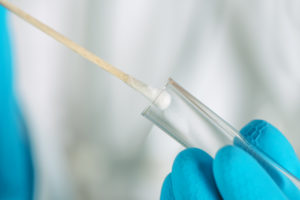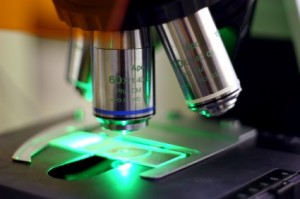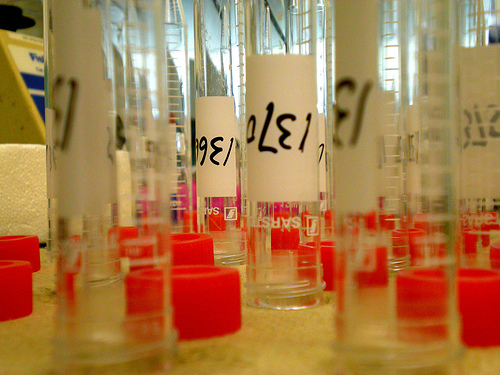Strengthening Forensic Science Includes Supporting Forensic Laboratory Funding
09.18.17 By Innocence Staff
DNA exonerations require, without exception, the hard work and involvement of forensic scientists who find, gather, preserve, test and analyze the evidence that proves the innocence of the Innocence Project’s clients. September 17-23, 2017, is National Forensic Science Week. This week is devoted to recognition of the important role that forensic science plays in the investigation of crimes, and provides an opportunity to reflect on the importance of strong, well-supported forensic science service providers and the infrastructure and laboratory operations support needed to set these laboratories up for success.
Now more than ever, forensic science service providers are both underfunded and, at the same time, under enormous pressure to process an ever-increasing amount of evidence. This dynamic can force laboratories to limit the funds they spend on infrastructure such as software that helps track evidence as it moves through the system and radio-frequency identification tags (RFID) that permit the physical location of forensic evidence and on updating large-ticket instruments.

Laboratories are also limited in their operations spending which hinders the ability to fund additional staff to manage increases in workload, conference travel for continuing education and training for new methodologies and scientific advances. Ninety-five percent of forensic analyses is conducted at the state, county, tribal and local level. When forensic science service providers are not given the support they need, wrongful convictions can occur.
Take one example of where things can go horribly wrong when labs do not have adequate funding for infrastructure. Henry James spent nearly 30 years in prison for a crime he did not commit. As DNA testing was not available when he was convicted in 1982, he sought testing in 2005. His evidence was thought to be lost until Milton Dureau, a crime lab official who had committed Mr. James’s case number to memory after searching for it for years, stumbled upon the evidence while looking for evidence in an unrelated case.
While we are grateful for Mr. Dureau’s efforts, individuals accused or convicted of crimes should not have to rely on good fortune and the memories of laboratory staff across decades to locate their evidence. Stronger laboratory infrastructure, such as technology that organizes, tracks and locates evidence, could have aided Mr. James’ exoneration sooner and could have potentially reduced his incarceration by at least five years.
The Bloodsworth Post-Conviction DNA Testing Grant Program has helped forensic science service providers defray the costs associated with postconviction DNA testing where there is a claim of actual innocence. These funds also have helped some laboratories implement the infrastructure they need to locate and analyze biological evidence associated with these cases.

The high demand for forensic testing, paired with insufficient operational funding, has also led to the use of less reliable, but time-saving alternatives to high-quality laboratory testing. Although nothing should replace confirmatory laboratory testing of controlled substances, in many jurisdictions across the country, law enforcement officials rely on inexpensive roadside testing to identify illegal substances.
Field drug test kits are highly sensitive and but are also highly susceptible to false positives. This is why the U.S. Department of Justice determined in 1978 that they should not be used for evidentiary purposes. They are inadmissible in court in nearly every jurisdiction, and prosecutors have to present laboratory test results based on more specific confirmatory tests. Prosecutors may, however, allow people to plead guilty based on the field drug tests, which is a huge problem given that 95% of felonies are resolved through guilty pleas.
Like many justice agencies across the country, officials in Harris County, Texas, commonly used roadside testing to identify illegal substances. Although it was not required to do so, the Houston Forensic Science Center tested evidence in which defendants pled guilty before going to trial. Through this testing, the laboratory detected no controlled substances in 212 of the 301 cases in which a positive field test led to an arrest by the Houston Police Department. All of these innocent defendants had taken guilty pleas.
The Harris County District Attorney dismissed those cases, notified defendants who had wrongly pleaded guilty to drug possession based on the faulty drug tests, and established a new policy that did not permit plea deals in drug possession cases until a laboratory test report was issued. In addition, the state of Texas enacted a law requiring the Texas Forensic Science Commission to study the accuracy, quality and reliability of presumptive drug tests and report their recommendations to the legislature and governor.

While Harris County is doing its best to address those wrongful convictions, the volume of controlled substances requests is so high across the country that most cases are not processed at the laboratory and many individuals charged with possession tend to take pleas regardless of their guilt. Every defendant charged with a crime deserves to have the evidence in his or her case processed with valid and reliable scientific techniques. The Coverdell Forensic Science Improvement grants are the only federal grant that provides forensic science and forensic medicine service providers with the operational support they need to improve the quality and timeliness of non-DNA forensic testing. If increased Coverdell funding were available, more laboratories would be able to support forensic testing without having to prioritize a category of cases over another.
These cases are some of the reasons why the Innocence Project and the Innocence Network advocate in concert with other criminal justice stakeholders for increases in funding for federal forensic science programs such as the Bloodsworth Post-Conviction DNA Testing Grant Program and the Coverdell Forensic Science Improvement Grant Program. By helping to support crime labs and the forensic testing they do, these programs help ensure that the innocent are identified. Reliable and timely lab findings are critical to the Innocence Project’s and Innocence Network’s work on behalf of their clients nationwide.
Additionally, the Innocence Project would like to recognize the challenges that forensic science service providers in Texas and Florida have faced as a result of Hurricanes Harvey and Irma. A subsequent blog this week will highlight the effort of one crime laboratory in the wake of an unimaginable natural disaster.

Leave a Reply
Thank you for visiting us. You can learn more about how we consider cases here. Please avoid sharing any personal information in the comments below and join us in making this a hate-speech free and safe space for everyone.